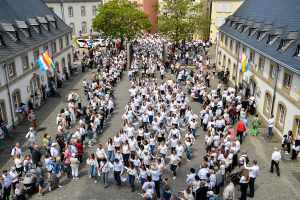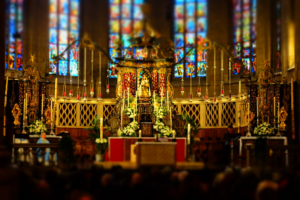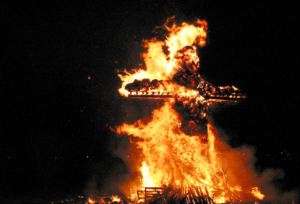Long rows of five people are intertwined by white handkerchiefs. They bounce to the sound of folk music along the established two-kilometre route through the streets of Echternach. This is the dancing procession, or Sprangprozessioun in Luxembourgish.
Every Whit Tuesday, the celebration brings the otherwise sleepy border town along Germany to life. But it underwent a number of changes before being listed as a Unesco Intangible Cultural Heritage of Humanity in 2010, as Hérold Pettiau and Tom Becker, researchers respectively at the Institute of History and the Department of Geography and Spatial Planning at the Faculty of Humanities, Education and Social Sciences, point out.
While UNESCO mentions traces of this procession as far back as 1100, the two researchers underline that there are differing views on the question of when the procession became a dance in Echternach. The founder of the abbey of Echternach, Willibrord, was born around 658 and died in 739: “In the decades that followed, we have references to miracles, such as people visiting his tomb and being cured of illnesses”, explains Hérold Pettiau. At the time, the activity was more akin to a pilgrimage.
Dances deemed ‘decadent’
Now considered to be the country’s second patron saint after Notre-Dame de Luxembourg, Saint Willibrord’s influence at the time extended beyond the country’s current borders. Tom Becker points out that an inscription on the church wall in Waxweiler, Germany, refers to a dancing procession in 728, a date he considers to be erroneous in light of sources dating back to the end of the 10th century, in a text by the Prüm monk Bernon, and to the 15th century of ‘dancing saints’ on Ascension Day in the Eifel.
“Willibrord became something of a cross-border saint, because at the time, the Eifel was part of Luxembourg,” points out Tom Becker. But in 1778, the Archbishop of Trier had the dancing procession in Prüm banned. Dancing was considered decadent at the time, and “there are numerous references to ecclesiastical condemnations of dancing throughout the Middle Ages and into modern times, even though the Church had to adapt”, points out Hérold Pettiau.
The ban on dancing was only temporary in Echternach, the tradition resumed under the French regime and became a permanent setting.
Visitor numbers changing over time
Over the years, the driving forces behind the event have changed. For example, the half-day holiday on Whit Tuesday for civil servants is no longer systematic, but simply added to the quota of recreation days. In schools, the prior agreement of parents is required before children can take part, which can limit attendance. Attendance fell below 10,000 in 2022, according to data from the Archdiocese.
“There are fewer participants every year,” admits Tom Becker, who sees this tradition changing significantly. “On one hand, the religious dimension linked to the veneration of Saint Willibrord plays a role. But on the other, there’s a more folkloric aspect and that of a street festival in town”. The procession remains, but its interpretation is evolving.
The researcher also highlights the involvement of expatriate communities such as the Portuguese in continuing the tradition. Furthermore, the documentation centre dedicated to the Sprangpressessioun helps its visibility through a year-round showcase. A way of passing on this tradition well beyond Whit Tuesday.
Image at the top: © Cathol.lu SCP S.Feltes


